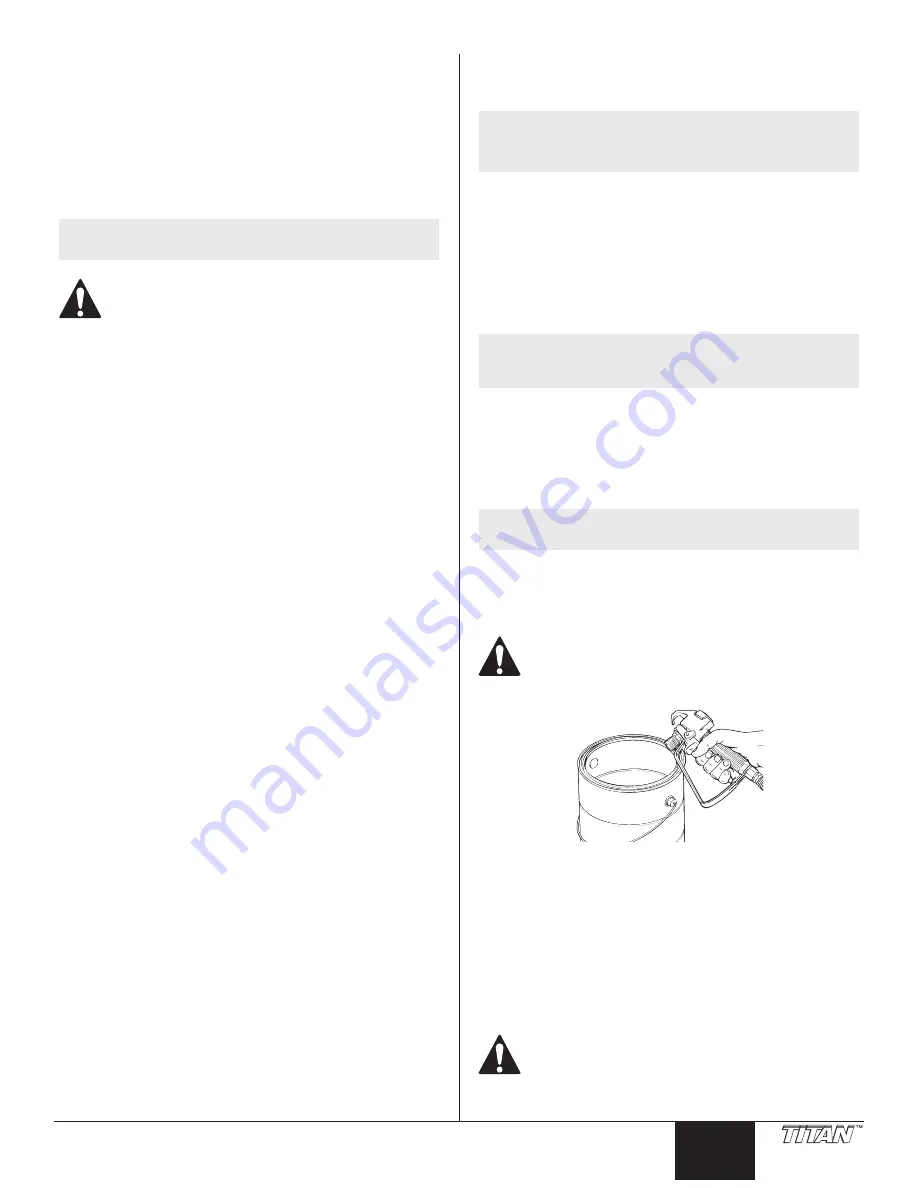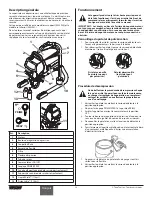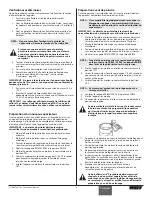
English
English
© Titan Tool Inc. All rights reserved.
5
Setup
Perform the following procedure before plugging in the power cord
of an electric unit.
1. Ensure that the siphon tube and the return hose are attached
and secure.
2. Using a wrench, attach a minimum of 50’ of 1/4” airless spray
hose to the outlet fitting on the sprayer. Tighten securely.
3. Attach an airless spray gun to the spray hose. Using two
wrenches (one on the gun and one on the hose), tighten
securely.
NOTE: Do not attach the tip to the spray gun yet. remove
the tip if it is already attached.
make sure all airless hoses and spray guns are
electrically grounded and rated at or above the
maximum operating pressure range of the airless
sprayer.
4. Make sure the pressure control knob is turned fully
counterclockwise to its lowest pressure setting.
5. Make sure the ON/OFF switch is in its OFF position.
6. Fill the oil cup with approximately one tablespoon of Piston
Lube™ (see “Accessories” section, page 54).
ImPOrTaNT: Never operate unit for more than ten seconds
without fluid. Operating this unit without fluid will cause
unnecessary wear to the packings.
7. Make sure the electrical service is 120V, 15 amp minimum.
8. Plug the power cord into a properly grounded outlet at least
25’ from the spray area.
ImPOrTaNT: always use a minimum 12 gauge, three-wire
extension cord with a grounded plug. Never remove the third
prong or use an adapter.
Preparing a New Sprayer
If this sprayer is new, it is shipped with test fluid in the fluid section to
prevent corrosion during shipment and storage. This fluid must be
thoroughly cleaned out of the system with mineral spirits before you
begin spraying.
ImPOrTaNT: always keep the trigger lock on the spray gun in
the locked position while preparing the system.
1. Place the siphon tube into a container of mineral spirits.
2. Place the return hose into a metal waste container.
3. Set the pressure to minimum by turning the pressure control
knob fully counterclockwise.
4. Move the PRIME/SPRAY valve down to the PRIME position.
5. Turn on the sprayer by moving the ON/OFF switch to the ON
position.
6. Allow the sprayer to run for 15–30 seconds to flush the
test fluid out through the return hose and into the waste
container.
7. Turn off the sprayer by moving the ON/OFF switch to the OFF
position.
Preparing to Paint
Before painting, it is important to make sure that the fluid in the
system is compatible with the paint that is going to be used.
NOTE: Incompatible fluids and paint may cause the valves
to become stuck closed, which would require
disassembly and cleaning of the sprayer’s fluid
section.
ImPOrTaNT: always keep the trigger lock on the spray gun in
the locked position while preparing the system.
1. Place the siphon tube into a container of the appropriate
solvent. Examples of the appropriate solvent are water for
latex paint or mineral spirits for oil-based paints.
2. Place the return hose into a metal waste container.
3. Set the pressure to minimum by turning the pressure control
knob fully counterclockwise.
4. Move the PRIME/SPRAY valve down to the PRIME position.
NOTE: Hold the return hose in the waste container when
moving the PrImE/SPray valve to PrImE in case the
sprayer is pressurized.
5. Turn on the sprayer by moving the ON/OFF switch to the ON
position.
6. Allow the sprayer to run for 15–30 seconds to flush the old
solvent out through the return hose and into the metal waste
container.
7. Turn off the sprayer by moving the ON/OFF switch to the OFF
position.
NOTE: make sure that the spray gun does not have a tip or
tip guard installed.
8. Move the PRIME/SPRAY valve up to the SPRAY position.
9. Turn on the sprayer.
10. Unlock the gun by turning the gun trigger lock to the
unlocked position.
Ground the gun by holding it against the edge of the
metal container while flushing. Failure to do so may
lead to a static electric discharge, which may cause a
fire.
11. Trigger the gun into the metal waste container until the old
solvent is gone and fresh solvent is coming out of the gun.
12. Lock the gun by turning the gun trigger lock to the locked
position.
13. Set down the gun and increase the pressure by turning the
pressure control knob slowly clockwise.
14. Check the entire system for leaks. If leaks occur, follow the
“Pressure Relief Procedure” in this manual before tightening
any fittings or hoses.
15. Follow the “Pressure Relief Procedure” in this manual before
changing from solvent to paint.
Be sure to follow the “Pressure relief Procedure” when
shutting down the sprayer for any purpose, including
servicing or adjusting any part of the spray system,
changing or cleaning spray tips, or preparing for
cleanup.






































